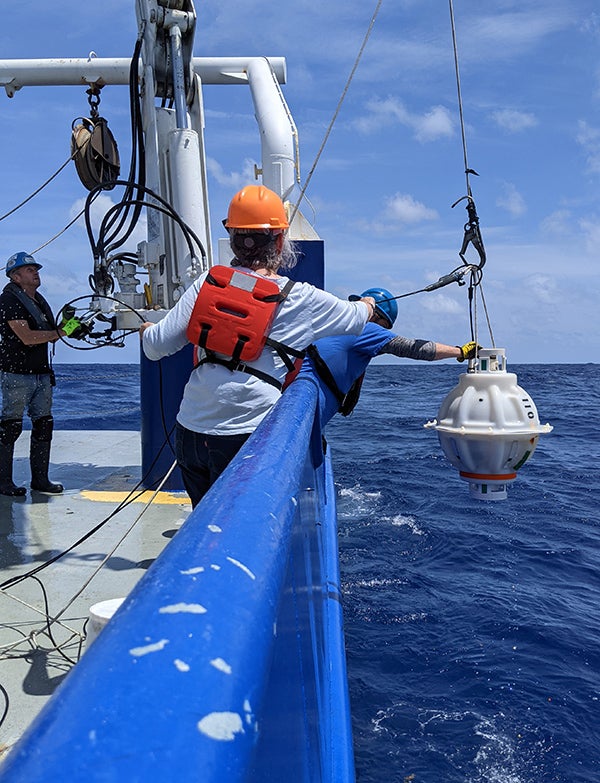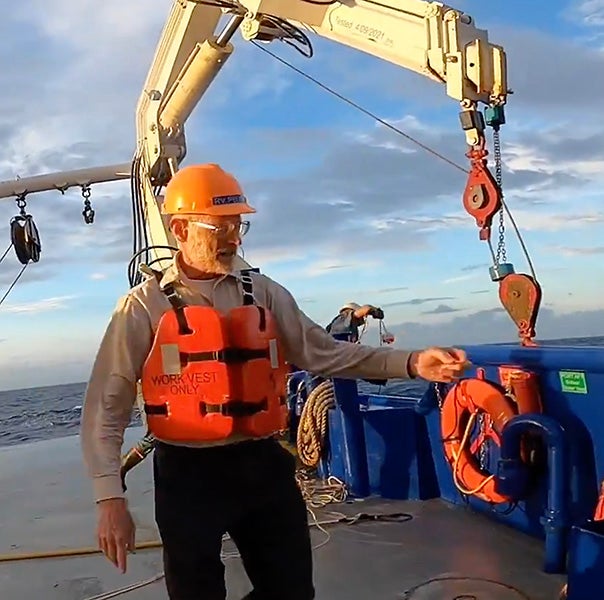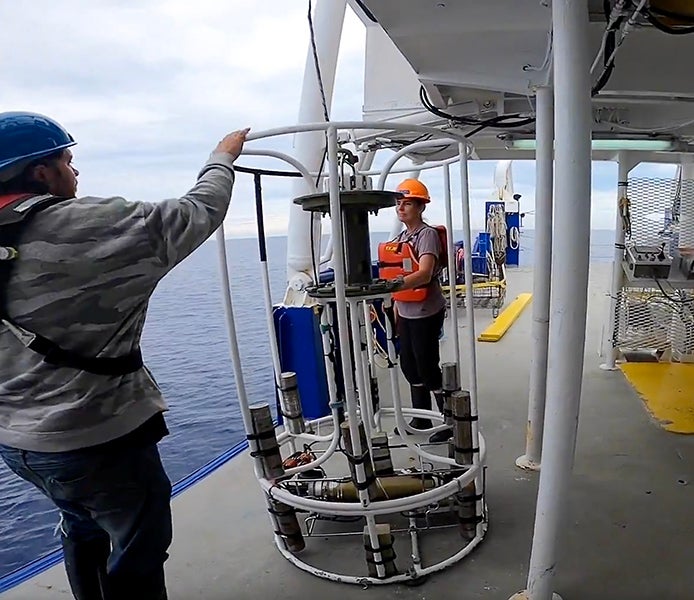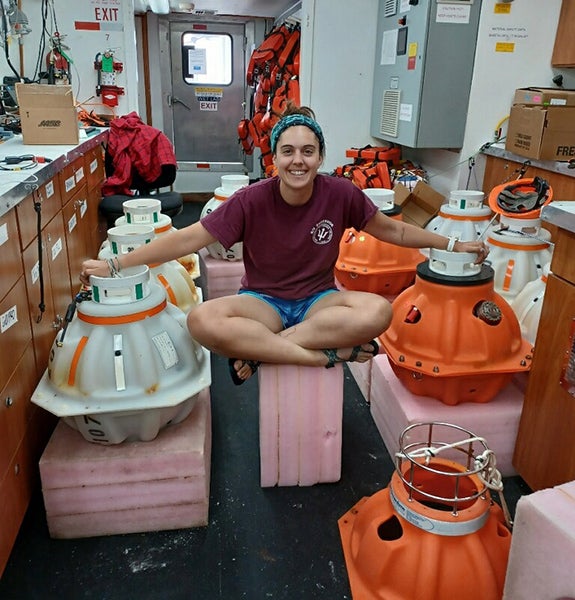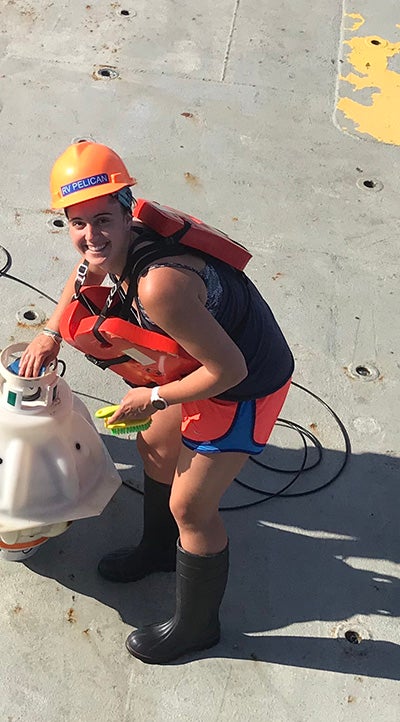“The Loop Current influences a wide variety of ocean processes that have implications for hurricane intensity, harmful algal blooms, oil and gas operations, fishing, tourism and other human and natural activities.”
By Todd McLeish
In May of 2021, a team of five GSO scientists spent two weeks retrieving 24 sensors from the seafloor in the deepest part of the Gulf of Mexico as part of a long-term, collaborative effort to better understand the Gulf’s Loop Current system. The instruments had been collecting data every hour since being deployed two years earlier.
According to Professor Kathleen Donohue, who led the project with Professor D. Randolph Watts, the Loop Current is the dominant ocean circulation feature in the Gulf. It enters the region from the Caribbean through the Yucatan Channel and travels in a loop around the Gulf, exiting between Cuba and Florida, where it becomes the Florida Current and eventually the Gulf Stream.
“Occasionally a loop will close off and generate a really large eddy or ring, and that large ring will propagate into the western Gulf,” said Donohue. “That eddy-shedding event energizes the whole Gulf.”
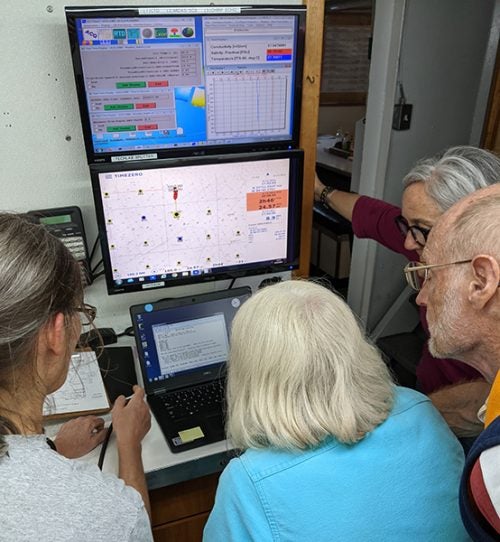
The Loop Current influences a wide variety of ocean processes that have implications for hurricane intensity, harmful algal blooms, oil and gas operations, fishing, tourism and other human and natural activities. Despite its importance, little is known about the current’s dynamics below the ocean surface.
Information Please
“We know a lot about what happens in upper ocean currents, but we don’t know what’s happening in the deep,” Donohue said. “We’re hoping to collect measurements from the full water column and show that they have value for understanding and predicting the Loop Current.
“We know, for instance, that when an eddy forms, there’s a transfer of energy between the surface currents and the deep,” she added. “It’s a way of injecting energy into the deep ocean. We suspect that deep energy radiates out to the boundaries of the Gulf. The boundaries are steep and can get very strong currents along these escarpments. I’d like to better understand that process.”
The project was funded with a $2 million grant from the Gulf Research Program of the National Academies of Sciences, Engineering and Medicine, funds that were made available as a result of the Deepwater Horizon oil spill.
“We were caught a little flat-footed in 2010 when the oil spill happened because we didn’t know enough about the Loop Current to know where the oil would go,” said Donohue. “We don’t have a lot of predictability in the Loop Current system right now. This project is an effort at predictability, to create a forecasting system that works well.”
The sensors used to gather data about the Loop Current in the water column are called Current and Pressure Recording Inverted Echo Sounders or CPIES. Developed by Watts and GSO Professor Emeritus H. Thomas Rossby in the 1970s, the instruments measure the pressure and current in the deep ocean while also providing a temperature and salinity profile. All of this information provides the scientists with estimates of the current velocity throughout the water column.
Student Participation
Joining Donohue and Watts on the May 2021 cruise were doctoral student Ali Johnson, marine technician Laura Reed, and marine research specialist Maureen Kennelly. They departed from Cocodrie, Louisiana, aboard the R/V Pelican, operated by the Louisiana Universities Marine Consortium, and retrieved several instruments each day for nearly two weeks.
For Johnson, a native of Cape Elizabeth, Maine, who earned her master’s degree from GSO in 2020 and worked at the Naval Undersea Warfare Center in Newport before returning to GSO for a doctorate, the cruise was a tremendous learning experience.
“As a grad student, any time you go on a cruise, a big part of why you’re there is to learn. Learning how you organize and adapt on a research cruise is a really important skill to have as a researcher and future principal investigator,” she said. “With just five of us onboard, we were all working 12-hour shifts, plus one of us had to get up in the middle of the night to help with the recovery by the midnight shift, which only had two people on it, so there was not a lot of relaxation time.”
Johnson said that the instruments are somewhat fragile, and each one had to be partially disassembled when it was retrieved to remove its batteries before re-assembling it and packing it for shipment back to Rhode Island. The team also downloaded, processed and backed up the data from each instrument after its retrieval.
“It was a team effort, and no one had a single role,” she said. “I dipped my hands into all of those different things.”
Describing her typical day aboard the Pelican, Johnson said she began each shift at 6 a.m. with a CTD cast and retrieval, then they would retrieve one of the sensors, a process that would typically take three or four hours. The team retrieved two or three sensors each day.
“Once we got on station, we’d send the CTD down, prepare the lab for another instrument, and once the CTD was out of the water, we’d hover over the instrument and send commands to it to wake it up,” she said. “Once we were ready, we tracked it as it came up through the water column. When it reached the surface, we’d find it, bring it on deck, clean it and steam off to the next site. Each instrument sat for 24 hours before we could start taking it apart.”
With only one bad weather day and almost no implications from the COVID pandemic, Johnson could not have been happier to spend time in the Gulf.
“I love being at sea. I just generally love being on the ship and enjoy the rocking of the boat. It’s really fun,” she said. “I also loved learning about these instruments and getting hands-on with them. I learned so much while I was out there.
“And I love interacting with the crew and meeting new people,” added Johnson, who attended Semester at Sea as an undergraduate at Stonehill College and is working toward an academic career in oceanographic research and teaching. “It was such a unique experience that not a lot of people get to have. It was beautiful and warm, I got an early start to summer, and it was a nice break from the pandemic and all of the virtual classes. It was much needed face-to-face time.”
Toward Improved Forecasting
With the field work for the project now complete, the research team is spending its time analyzing the data in anticipation of sharing it with collaborators who will use the data in forecast models of the Loop Current.
“Most simulations of circulation in the Gulf of Mexico vastly underestimate the strength of the abyssal storms—the ocean analog of a winter storm—so we’re thinking that by including our data in their operational forecasting, it will help improve forecasting efforts,” Donohue said. “The Loop Current eddy-shedding process involves the generation of these deep abyssal storms, and the strength of the storms cannot be determined from surface observations alone.”
The research team has already submitted a proposal to continue this work in another part of the Gulf of Mexico. In the Fall of 2021, they traveled to the waters around Antarctica with the same instruments they used in the Gulf to conduct a similar project examining the Antarctic Circumpolar Current. The two-month cruise departed from South Korea and aimed to better understand how the ocean moves heat toward the South Pole.
“In the global energy balance, we have excess heating at the equator and cooling at the poles, and it’s the job of the ocean and atmosphere to move that heat toward the pole. The weather is the worker bee that does this,” explained Donohue. “The Antarctic Circumpolar Current goes zonally around Antarctica. The way you move heat poleward is through ocean storms, and there are hotspots of ocean storms that occur at submarine ridges.”
Donohue thinks of the currents around Antarctica as a multi-lane highway, and moving heat requires changing lanes several times rather than all at once.
“When we think about the heat hand-off in the Circumpolar Current, you get on the highway with heat from the subtropics, but you can only move across lanes at certain discrete places,” she said. “We’re going to one of the last stops south of Tasmania to see how heat gets across. We want to know how it works because, ultimately, that heat is eventually going to reach the Antarctic Current, and we want to understand the pathways.”

